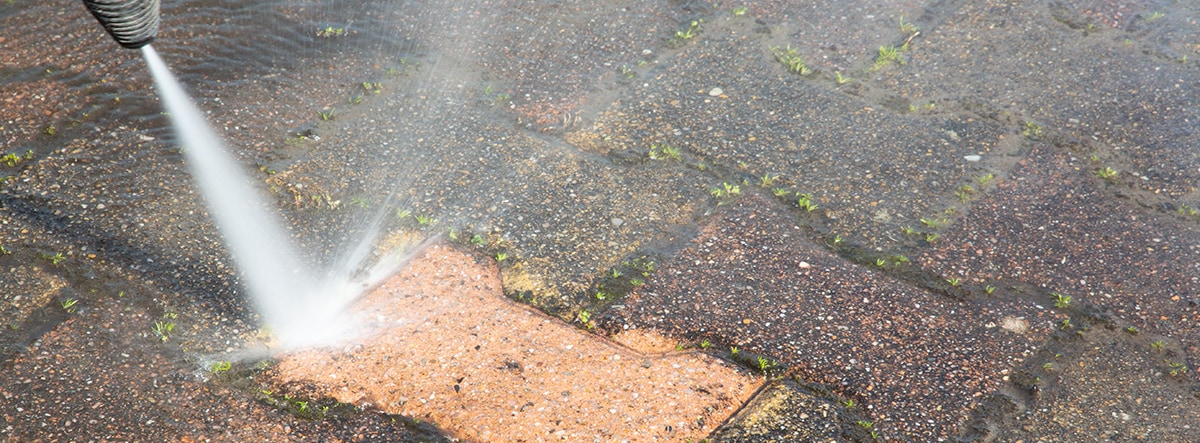
Pressure Washer FAQ's
Frequently Asked Questions About Pressure Washers
We often get the same questions from customers looking to get the most out of their pressure washers.
Whether you've never used a pressure washer before, or if you use one for work, these questions will help you troubleshoot, repair, and better understand your pressure washer.
Frequently Asked Questions About Pressure Washers
To skip directly to a specific question, please click on a link below:
Troubleshooting:
- How Do I Start My Electric Pressure Washer?
- Why Won't My Electric Pressure Washer Start?
- Why Did My Electric Power Washer Suddenly Stop?
- Why is My Electric Machine Cycling?
- Why Doesn't My Pressure Washer Reach Full Pressure?
- Why is My Pressure Washer Surging?
Using Pressure Washers, Attachments, and Hoses:
- Why Should My Pressure Washer Be Turned Off When Not In Use?
- Can You Connect Different Diameter Hoses Together?
- Can You Repair a Leaking Pressure Washer Hose?
- How Does a Hot Water Pressure Washer Work?
- Why Can't a Direct-Drive Pressure Washer Pull Water From a Tank?
Maintenance: Checking Oil, Replacing Plugs, Pumps, and More:
- How to Winterize a Pressure Washer
- How to Change the Oil on a Pressure Washer Pump and Engine
- What Type of Oil Does My Pressure Washer Take?
- How Do You Replace a Pressure Washer Plug?
- Why is My Pressure Washer Smoking?
Other Questions:
- Why is it Important for Nozzles to be Sized Correctly for GPM and PSI Requirements?
- What Is More Important, Flow (GPM) or Pressure (PSI)?
- What Are the Best Brands of Pressure Washers?
How Do I Start My Electric Pressure Washer?
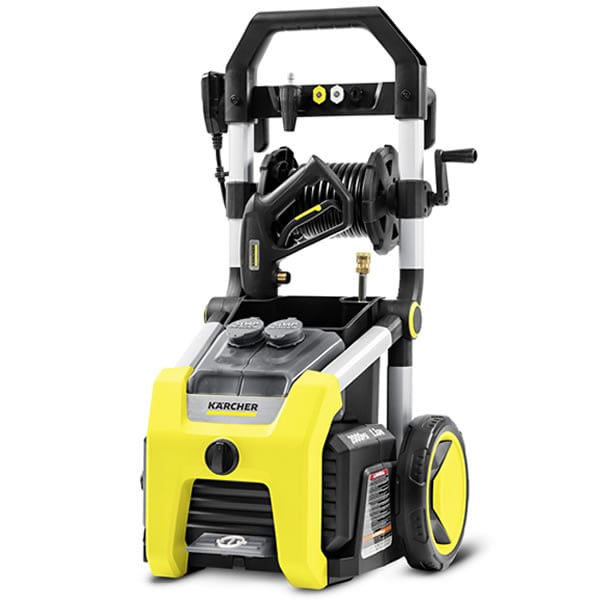 Attach a garden hose between water supply and pressure washer.
Attach a garden hose between water supply and pressure washer.- Attach a high-pressure hose between spray wand and pressure washer.
- Turn the water on.
- Depress the trigger on the spray wand to purge any water or air from the unit.
- Depress and hold the trigger on the spray wand to relieve any built-up pressure within the pump and continue to hold the trigger while switching to the "ON" position.
For Starting Gas Pressure Washers:
Why Won't My Electric Pressure Washer Start?
If your electric pressure washer won't start, there are a few things you should check.
Do not use an extension cord. They can drastically shorten the life of your machine. If you must use one, it must be 12 gauge wire if over 25 feet in length. Using any length of 16, 18 or lighter gauge extension cord will not supply enough power to your pressure washer and the motor will not start or run properly. This can also cause your fuse to blow or circuit breaker to trip. Running an electric pressure washer on a light-duty extension cord will cause permanent damage to internal switches and/or electric motor.
If your machine isn't making any noise at all, the first place to look is the electrical cord. Make sure that it is plugged directly into a wall outlet, has a tight connection and that your outlet can provide adequate grounded power to operate your pressure washer.
If the motor has stopped but is making a humming sound, it is usually a faulty capacitor.
For your protection, electric power washers use a Ground Fault Circuit Interrupter (GFCI) which sometimes trips. In order to reset it, follow the instructions provided in your owner's manual.
Why Did My Electric Power Washer Suddenly Stop?
Do not use an extension cord. They can drastically shorten the life of your machine.
- Check to see if the electric cord was unplugged.
- Check to see if the GFCI has been tripped.
- Check the main fuse box to see if the breaker has been tripped. Replug all cords and flip the breakers.
NOTE: to reset the GFCI, plug the GFCI into a "working" outlet and press the "Reset" button. The GFCI MUST be plugged into a working outlet for you to reset the switch. If the GFCI is not plugged into a working outlet it will not reset. DO NOT PLUG A GFCI PROTECTED CORD INTO A GFCI PROTECTED OUTLET. This will more than likely cause the GFCI to trip repeatedly.
An electric pressure washer requires a good stable supply of power with no other high amperage draw appliances running on the same circuit. High amperage appliances such as refrigerators, coffee machines, heaters, motors, etc., running on the same circuit as your pressure washer will cause fuses to blow or breakers to trip. If the motor has stopped making noise entirely, it could be a faulty power cord.
If the motor has stopped but is making a humming sound, it is usually a faulty capacitor. In either case, these parts would have to be tested to be certain.
Why is My Electric Machine Cycling?
Cycling is when the motor turns on and off when the trigger on the gun is not being pulled. It only occurs with electric units because most gas machines do not have a pressure switch. If your electric pressure washer turns on and off, continue reading this section.
When you connect your power washer to the water source and turn it on, the motor will run for a few seconds, building up pressure. Once it reaches a specific pressure (PSI) inside the pump, a pressure switch engages and turns the motor off. When you release this built-up pressure by pulling the trigger on the trigger gun, the pressure inside the pump drops, turning the motor on again. When you let go of the trigger, the pressure builds up inside the pump again and turns off the motor.
The pressure switch inside the pump controls when the motor turns on and off. Any release in pressure causes the pressure switch to activate the motor. Leaks are the biggest contributor to a cycling machine.
You should check the following:
- Verify if connections are tightened properly. Water leaking from a loose connection can cause the unit to cycle on and off.
- Verify if the pressure hose has an O-ring at the connection. If missing, this will also cause the unit to cycle on and off.
- While the unit is running look for any water leaks that may cause the unit to turn back on.
If you have low pressure, read below.
Why Doesn't My Pressure Washer Reach Full Pressure?
Pressure washers are known for using high water pressure to get the job done quickly and efficiently. If your pressure washer is not spraying hard enough, read this section.
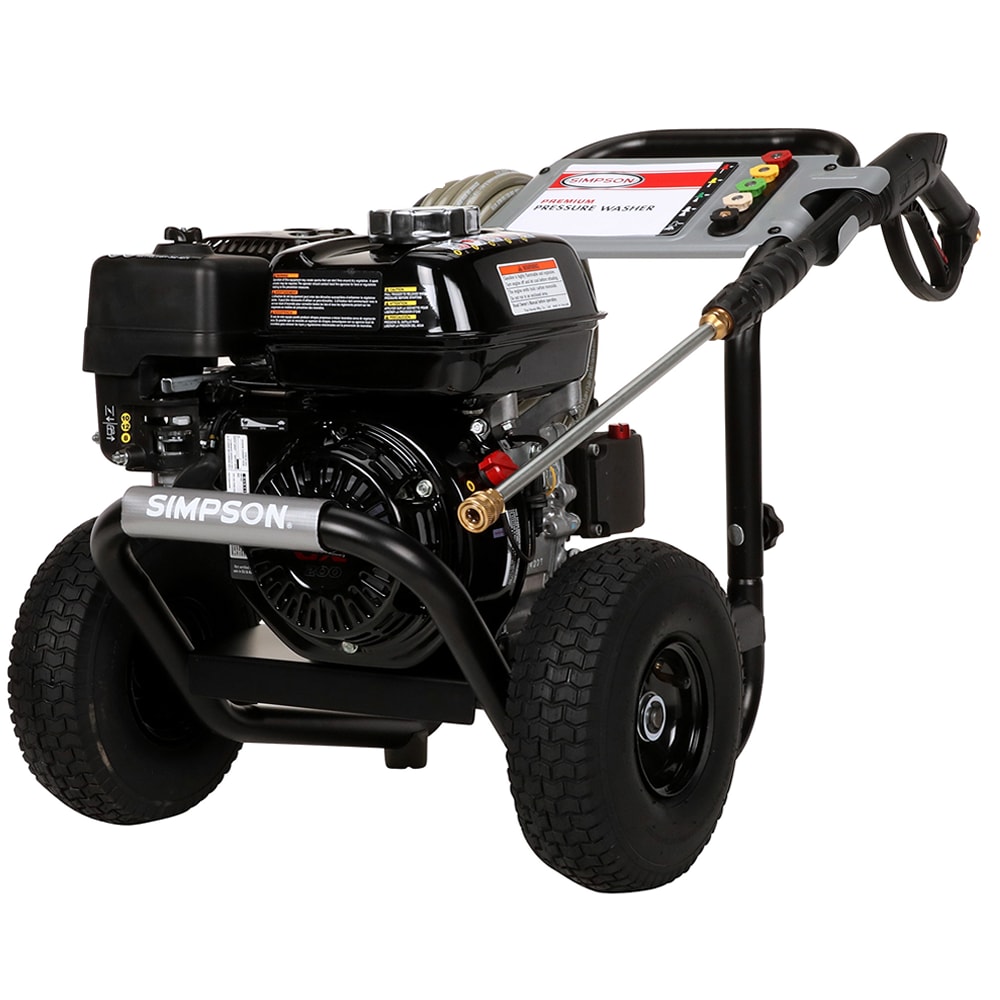 For Gas and Electric Machines
For Gas and Electric Machines
A loss of pressure can be caused by a number of things. Here are the things you should check first:
- Make sure your garden hose and pressure hose are not kinked, leaking, or blocked in any way, and that the water is turned on full-force and supplying the correct amount of water (GPM) outlined in your owner's manual.
- Remove the water inlet filter and make sure it is free of debris.
- Check the trigger gun and nozzles. They should be clean as well.
If you have completed these steps and the washer is still fluctuating from high to low pressure, there may be air trapped in the pump. To re-prime the pump of any air, turn the machine off and disconnect the high-pressure water hose and trigger gun from your power washer. With only the garden hose connected to the machine, turn on your water source and allow water to run through the pump of the machine for 20 or 30 seconds. Turn off the water and connect the pressure hose and trigger gun and try using the machine again.
For Electric Machines
Often times, a machine producing low pressure will surge, cycle on and off, or continue to run. This typically indicates that the machine is losing pressure somewhere, such as a leak in one of the lines or inside the case of the machine. The machine tries to compensate for this leak by running harder or more often than it should.
Why is My Pressure Washer Surging?
Water flow may be restricted to the pressure washer, although the causes of pressure washer surging can be varied.
First, check that all hoses are free of kinks, leaks, or blockage. Make certain all hoses and fittings are connected properly. Make sure to open the faucet/spigot to full force. Set the spray wand to high pressure.
Clear any debris from the nozzle. If the nozzle has even a little bit of dirt in the tip, it may cause enough obstruction for the pressure washer to pulsate. If your pressure washer came with a nozzle cleaner, use it to clean the tip. If not, you can use a small pin or a paper clip to clear the nozzle tip of debris that may have become lodged in it.
If these have been checked and the washer is still fluctuating from high to low pressure there may be air trapped in the pump. To re-prime the pump of any air, turn the machine off and disconnect the high-pressure water hose and trigger gun from your power washer.
With only the garden hose connected to the machine, turn on your water source and allow water to run through the pump of the machine for 20 or 30 seconds. Turn off the water and connect the high-pressure hose and trigger gun and try using the machine again.
Why Should My Pressure Washer Be Turned Off When Not In Use?
If you let a pressure washer run without pulling the trigger, the water stays inside the pump. This water continues to heat up and will melt the seals on the pump. Plus, the pump continues to heat up, so when you pull the trigger again, cold water is entering a very hot pump and can cause pump cavitation.
Some pumps have a bypass hose to recirculate the water and cool it down, but you still do not want to let it sit for long without pulling the trigger even with the bypass hose.
It's best to always turn the pressure washer off when not in use. If your pressure washer is not working, or if your pressure washer keeps shutting off, this may be a cause of the issue.
Can You Connect Different Diameter Hoses Together?
Yes, you can connect pressure washer hoses with different diameters together, as long as the connections match. Quick connects are the same size on 1/4" and 3/8" hoses, so power washer hoses can be connected together using quick-connect pressure washer fittings and hose couplers. We always suggest having the smallest diameter hose coming off the pump, so go from smaller to bigger so you do not restrict flow.
Also, when replacing a pressure washer hose, make sure it is a high-pressure hose.
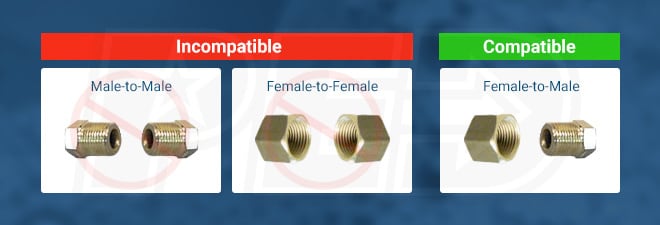
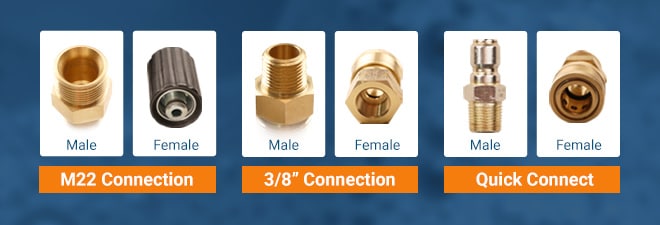
Can You Repair a Leaking Pressure Washer Hose?
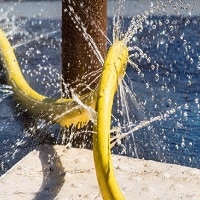 No, do not attempt to patch or repair a leaking pressure washer hose.
No, do not attempt to patch or repair a leaking pressure washer hose.
Pressure washer replacement hoses are carefully designed to evenly distribute pressure throughout the length of the hose, using specially designed wire mesh to help the hose hold its shape and layers of materials designed to harness the pressure.
Once the layers are compromised, you need to purchase another high-pressure hose to make sure your pressure washer can continue to be safely used.
How Does a Hot Water Pressure Washer Work?
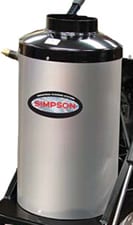 The differences between hot and cold pressure washers can get confusing. Many people think the burner is actually a tank and that the water goes through the pump heated, however, that is not true, and they can be used as a cold water machine as well.
The differences between hot and cold pressure washers can get confusing. Many people think the burner is actually a tank and that the water goes through the pump heated, however, that is not true, and they can be used as a cold water machine as well.
The large metal cylinder is not a tank, it is the burner that heats the water (most people think it is a tank for water storage). The water goes through the pump before it is heated, so the machine can be used as a cold water pressure washer as well.
Since the hot water doesn't go through the pump, it does not have to be rated for hot water. The hose, gun, and lance must be rated for hot water. So, a hot water machine operates the same as a cold one until the water exits the pump.
On a cold water pressure washer, water goes from the pump to the high-pressure hose and then to the gun. On a hot water pressure washer, it exits the pump and passes through a heating element before going to the hose and gun.
Why Can't a Direct-Drive Pressure Washer Pull Water From a Tank?
People often ask if they can pull water from a tank into their direct-drive pressure washers. Belt-driven pressure washers are meant to be gravity-fed from a tank. Direct-drive pumps run at a higher RPM than a belt-drive. Since direct-drive pumps spin so fast, they can not pull water.
How to Winterize a Pressure Washer
Whenever your pressure washer is not in use for more than 30 days, we recommend using the storing steps described in this section. Our article, How to Winterize a Pressure Washer, goes over each proper step in detail. Basically, you need to stabilize the fuel if you intend to keep it in the pressure washer, flush all water out of the machine, and add pump-saver to prevent your pump from freezing or building up moisture.
How to Change the Oil on a Pressure Washer Pump and Engine
You should always check the pump and engine oil level before using the machine. Both the pump and engine oil need to be changed on a pressure washer (unless you have an axial pump; axial pumps do not need to have the oil level checked since the pump is sealed). Click here to see what type of pump you have.
If you are having trouble checking the oil levels, we suggest getting a flashlight and getting to eye level with the sight glass. It is harder to see if you are looking down at it. If you have trouble bending down, you could also hold a phone right up to the sight glass and take a picture and view it on the phone. You can also rock the machine lightly so you can see the motion of the oil inside the pump.
Triplex pumps will have a sight glass to check the oil level. The oil level should be at the center of the red dot on the sight glass. The engine oil would be checked using the dipstick from the engine.
You do not want to just add more oil, you need to drain and change it out. The process of checking the oil in your pressure washer pump is similar to checking the oil for your car. Locate and take out the dipstick and wipe it off, then reinsert the dipstick and check that oil is at the correct level as marked on the dipstick.
The engine oil should be changed after the first 20 hours of use or after the 1st month of use, whichever is sooner. After the initial oil change, the engine oil should be changed every 6 months or 100 hours of use.
The pump oil should be changed after the first 50 hours of use. After the initial pump oil change, the oil should be changed every 100 hours of use or every 3 months, whichever is sooner. Cat pumps have 2 different pump oil change intervals. If you use the Cat brand pump oil, the oil changes would be every 500 hours of use. If you use other brands of oil on a Cat pump the oil would need to be changed every 300 hours.
What Type of Oil Does My Pressure Washer Take?
The key to pump oil is that it must be non-detergent and non-foaming. The proper engine oil for a pressure washer is always going to be listed in the owner's manual, based on the manufacturer's recommendations. SAE 10W-30 is the recommended oil for most pressure washers.
Depending on the temperature range it will be operated on, you can also use 10W-30, 10W-40, or synthetic 5W-30. Synthetic SAE 10W-30 will cover the largest temperature range and is good in all conditions, so this would be the recommended oil.
The proper pressure washer oil for a pump will also be recommended to you by the manufacturer, usually inside the owner's manual. Each manufacturer suggests a different pump oil.
Cat pumps suggest using the Cat premium-grade hydraulic oil (ISO-68). You can use other oils, but the oil change interval will change if you do (see the FAQ above). Simpson suggests using Simpson Premium pump crankcase oil or SAE 15W-40. Karcher and General pumps recommend using SAE 15W-40. AR says to use 30W non-detergent oil.
How Do You Replace a Pressure Washer Plug?
Every pressure washer pump is going to have a type of vented oil plug to keep the oil in the pump. Many of the General Pumps have the oil plug with a dipstick on it to check the oil.
The Cat and Comet pumps usually ship with a sealed plug inserted that needs to be changed when it arrives. If a pressure washer was shipped with a vented plug inserted, much of the oil would leak out during shipping. So, most models ship with a sealed plug that needs to be switched out before using the machine. The sealed plug is threaded and simply unscrews, and the vented plug screws back in the same way.
Many parts of the pressure washer can get covered in oil depending on the shipping methods and arrival, which can cause problems if not addressed. The air filter getting covered in oil is the most common problem. Oil on the spark plug is also an occasional problem area. When this happens you need to remove the air filter and spark plug and wipe them off and dry them.
Next, with the spark plug out, pull the recoil to remove any extra oil. This step can be messy and should be done in an area where oil spray will not damage or stain anything (usually best to do in the grass). Once no more oil comes out from where the plug was, you can reassemble the washer, check the oil levels, and it will be ready to use.
Why is My Pressure Washer Smoking?
Seeing a pressure washer smoking can be startling. However, most of the time, white smoke coming from your pressure washer is just residual oil is burning off somewhere on the engine. There is no way to stop this or prevent it. It will not cause any damage to the engine and usually only happens the first time it's turned on.
If you continue experiencing a smoking pressure washer after the first use, if the smoke turns black, or if your pressure washer continues to shut itself off, there may be another issue with your pressure washer, and we recommend checking the other FAQ's on this page for details about starting a pressure washer or what to do if it keeps cycling, surging, or continues to shut off.
Why is it Important for Nozzles to be Sized Correctly for GPM and PSI Requirements?
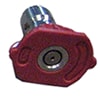 If the nozzles are not sized to the pressure washer PSI and GPM requirements, it will not perform properly. If the orifice size is too small, it will restrict water flow and if it is too large, it will lower the desired PSI output. It is important to use a sizing chart to determine the correct orifice size. (See orifice chart attachment below). When replacing a pump the orifice size required may change if they are going to a different PSI or GPM.
If the nozzles are not sized to the pressure washer PSI and GPM requirements, it will not perform properly. If the orifice size is too small, it will restrict water flow and if it is too large, it will lower the desired PSI output. It is important to use a sizing chart to determine the correct orifice size. (See orifice chart attachment below). When replacing a pump the orifice size required may change if they are going to a different PSI or GPM.
Don't forget that when you upgrade your pump, you need to resize your spray tips to ensure that these requirements are still being met to continue safely using your pressure washer.
Orifice Sizing Chart
![[Orifice Sizing Chart for Pressure Washer Nozzles]](https://www.pressurewashersdirect.com/images/Orifice Sizing Chart for Pressure Washer Nozzles.jpg)
What Is More Important, Flow (GPM) or Pressure (PSI)?
This will always depend on the application. For stubborn, hard-to-remove dirt, a pressure washer's PSI is more important. For large amounts of dirt, a pressure washer's GPM is more important. When given the choice, you should always lean towards more GPM (flow) over PSI (pressure). You can change spray tips and move closer to what you are cleaning to increase pressure, but there is no way to increase flow. However, with more PSI comes a greater chance of damaging what you are cleaning.
It is important to keep in mind that different surfaces have different recommended pressure ratings. See the chart below for some recommended pressure ratings per application.
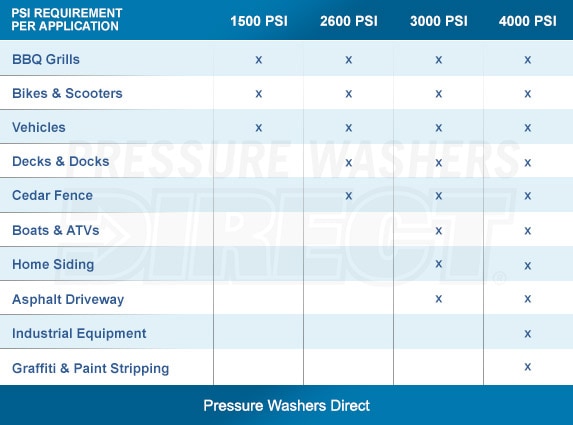
What Are the Best Brands of Pressure Washers?
When it comes to the best pressure washer brands, we normally recommend focusing less on the brand name and more on the performance of the engine and reliability of the pump.
If you want to know what's hot in the market or what our experts recommend, we have our 'Best Pressure Washers of the Year' program, where we list the top-rated, best-selling, and expert-recommended pressure washers in every major category. The lists are accurately reflected and updated in real-time.
Share My Personal Information\":{\"href\":\"https:\\\/\\\/ferguson.bigidprivacy.cloud\\\/consumer\\\/#\\\/dMf02ovZbN\\\/Form-NHWperWAaFNVIQK\",\"title\":\"Do Not Sell or Share My Personal Information\"}},\"About Us\":{\"Our Stores\":{\"href\":\"https:\\\/\\\/www.powerequipmentdirect.com\\\/our-stores.php\",\"title\":\"Power Equipment Direct's Stores\"},\"Our Story\":{\"href\":\"https:\\\/\\\/www.powerequipmentdirect.com\\\/stories\\\/1982-How-We-Make-Buying-Technical-Products-Simple.html\",\"title\":\"Power Equipment Direct's Story\"},\"Careers\":{\"href\":\"https:\\\/\\\/www.powerequipmentdirect.com\\\/stories\\\/1924-Job-Openings.html\",\"title\":\"Careers @ Power Equipment Direct\"},\"Newsroom\":{\"href\":\"newsreleases.php\",\"title\":\"Power Equipment Direct News Center\"}},\"Contact Us\":{\"phone\":\"800-710-7499\",\"hours\":[\"M-F: 8-5 CST\",\"Sat: Closed\",\"Sun: Closed\"]}}","storeLinkJSON":"{\"AC Wholesalers\":{\"href\":\"https:\\\/\\\/www.acwholesalers.com\",\"title\":\"AC Wholesalers\"},\"Air Compressors Direct\":{\"href\":\"https:\\\/\\\/www.aircompressorsdirect.com\",\"title\":\"Air Compressors Direct\"},\"Chain Saws Direct\":{\"href\":\"https:\\\/\\\/www.chainsawsdirect.com\",\"title\":\"Chain Saws Direct\"},\"Chippers Direct\":{\"href\":\"https:\\\/\\\/www.chippersdirect.com\",\"title\":\"Chippers Direct\"},\"eComfort\":{\"href\":\"https:\\\/\\\/www.ecomfort.com\",\"title\":\"eComfort\"},\"Electric Generators Direct\":{\"href\":\"https:\\\/\\\/www.electricgeneratorsdirect.com\",\"title\":\"Electric Generators Direct\"},\"Leaf Blowers Direct\":{\"href\":\"https:\\\/\\\/www.leafblowersdirect.com\",\"title\":\"Leaf Blowers Direct\"},\"Log Splitters Direct\":{\"href\":\"https:\\\/\\\/www.logsplittersdirect.com\",\"title\":\"Log Splitters Direct\"},\"Mowers Direct\":{\"href\":\"https:\\\/\\\/www.mowersdirect.com\",\"title\":\"Mowers Direct\"},\"Power Equipment Direct\":{\"href\":\"https:\\\/\\\/www.powerequipmentdirect.com\",\"title\":\"Power Equipment Direct\"},\"Pressure Washers Direct\":{\"href\":\"https:\\\/\\\/www.pressurewashersdirect.com\",\"title\":\"Pressure Washers Direct\"},\"Snow Blowers Direct\":{\"href\":\"https:\\\/\\\/www.snowblowersdirect.com\",\"title\":\"Snow Blowers Direct\"},\"String Trimmers Direct\":{\"href\":\"https:\\\/\\\/www.stringtrimmersdirect.com\",\"title\":\"String Trimmers Direct\"},\"Sump Pumps Direct\":{\"href\":\"https:\\\/\\\/www.sumppumpsdirect.com\",\"title\":\"Sump Pumps Direct\"},\"Tillers Direct\":{\"href\":\"https:\\\/\\\/www.tillersdirect.com\",\"title\":\"Tillers Direct\"},\"Water Pumps Direct\":{\"href\":\"https:\\\/\\\/www.waterpumpsdirect.com\",\"title\":\"Water Pumps Direct\"}}","socialLinkJSON":"{\"Facebook\":{\"href\":\"https:\\\/\\\/www.facebook.com\\\/PowerEquipmentDirect\",\"icon\":\"icon-facebook\",\"title\":\"Facebook\"},\"Twitter\":{\"href\":\"http:\\\/\\\/twitter.com\\\/PowerEquipment\",\"icon\":\"icon-twitter\",\"title\":\"Twitter\"},\"Pinterest\":{\"href\":\"http:\\\/\\\/pinterest.com\\\/powerequipment\\\/\",\"icon\":\"icon-pinterest\",\"title\":\"Pinterest\"},\"YouTube\":{\"href\":\"http:\\\/\\\/www.youtube.com\\\/PowerEquipmentDirect\",\"icon\":\"icon-youtube\",\"title\":\"YouTube\"},\"Instagram\":{\"href\":\"https:\\\/\\\/www.instagram.com\\\/powerequipmentdirect\\\/\",\"icon\":\"icon-instagram\",\"title\":\"Instagram\"},\"LinkedIn\":{\"href\":\"https:\\\/\\\/www.linkedin.com\\\/company\\\/power-equipment-direct\\\/about\\\/\",\"icon\":\"icon-linkedin\",\"title\":\"LinkedIn\"}}","miscLinkJSON":"{\"Terms of Use\":{\"href\":\"terms-of-use.php\",\"title\":\"Terms of Use\"},\"Privacy Policy & Security\":{\"href\":\"privacy.php\",\"title\":\"Privacy Policy and Security\"},\"Cookie Policy\":{\"href\":\"privacy.php#cookiePolicy\",\"title\":\"Cookie Policy\"},\"CA Privacy Rights\":{\"href\":\"privacy.php#californiaPrivacyRights\",\"title\":\"CA Privacy Rights\"},\"copyright\":\"© 2024 Power Equipment Direct. All Rights Reserved\"}","checkoutMiscLinkJSON":"{\"Privacy Policy & Security\":{\"href\":\"privacy.php\",\"title\":\"Privacy Policy and Security\"},\"Cookie Policy\":{\"href\":\"privacy.php#cookiePolicy\",\"title\":\"Cookie Policy\"},\"Terms of Use\":{\"href\":\"terms-of-use.php\",\"title\":\"Terms of Use\"},\"copyright\":\"© 2024 Power Equipment Direct. All Rights Reserved\"}","expertJSON":{"imageURL":"https:\/\/www.powerequipmentdirect.com\/images\/experts\/expert-main-13.png","href":"\/product-experts.php?s=13","title":"Contact Dale @ Power Equipment Direct","expertName":"Dale","expertTitle":"Power Equipment Expert"},"bbbJSON":{"imageURL":"https:\/\/www.powerequipmentdirect.com\/images\/badge-bbb.png","imageAlt":"Better Business Bureau","href":"http:\/\/www.bbb.org\/chicago\/business-reviews\/industrial-equipment-and-supplies\/power-equipment-direct-in-bolingbrook-il-57001088","title":"Power Equipment Direct - A+ Rating - Better Business Bureau"},"zipCode":null,"phoneNumber":"800-710-7499","loginToken":"page cache precludes the use of csrf tokens","iterable":"e4b27e68b9c84fbb940829a0a9ee29d7","newNav":false}

